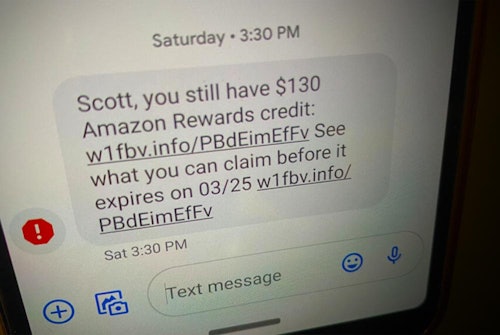Amazon In Depth
Amazon is one of the largest online retailers globally, which unfortunately has led to a plethora of Amazon scams. Started in 1994 by Jeff Bezos, the company has grown from selling only books to selling everything from clothing to home goods, food, and electronics. Amazon now has more than 150 million paying Amazon Prime Members and more than 212 million unique visitors each month.
In addition to being an online retailer, Amazon is also a technology company. In 2002 Amazon launched a cloud-computing service called Amazon Web Services. The company also developed and started selling the Kindle e-reader in 2007 and the Kindle Fire tablet computer, in 2012. Even with success on the business's technology side, Amazon's main profits come from e-commerce.
Common Amazon Scams
Amazon is a large company with millions of customers and sellers, making it a prime target for scams. Some of the most common Amazon scams you should be aware of include:
- Gift card scams
- Job scams
- Phishing scams
- Voucher/coupon scams
- Fake review scams
- Delivery scams
- Brushing scams
- Amazon Prime renewal scams
Amazon Gift Card Scam
In this Amazon gift card scam, you're contacted by a scammer by phone, email, or social media. They will claim they work for Amazon and says you owe money on your account. The scammer will request you pay the fee in the form of an Amazon gift card.
Once you buy the gift card, the scammer will ask for the claim code on the back of the card and use the entire balance. At this point, the scam is complete—there was never any amount owing on your Amazon account, and you'll never hear from the scammer again.
Amazon Job Scam
Scammers will call and ask if you're interested in a remote position with Amazon. If you're interested, you're directed to a fake Amazon job site to complete an application. These fake applications will ask for personal information, which the scammer can use to steal your identity. These Amazon scams could also come via email that directs you to apply for a fake Amazon job.
Amazon Phishing Scams
Phishing scams are among the most common Amazon scams where scammers attempt to steal your personal information. In this scam, you receive an email or text from a fake Amazon account claiming something is wrong with your account or recent order, and you need to sign in to fix it. There's also a version of this scam where the message says you've won a free gift or reward.

Within the email, you'll get a link to sign in to your account, which will bring you to a fake Amazon page. When you enter your information, your credentials are sent to the scammer. The scammer uses this information to sign in to your account and steal additional details. This scam can also happen over the phone, where the scammer asks you to tell them your login information, and even via a text message that includes a link to a phishing website.

Amazon Voucher Scam
In this Amazon scam, you're sent an email claiming Amazon wants to reward you for being loyal and offers a phony voucher good toward any Amazon purchase. To claim the coupon, you'll need to click on a link that directs you to a page where you'll enter your Amazon login information. Once you enter your data, the Amazon scammers will be able to log into your account.

Amazon Review Scam
Sellers can lose their credibility when scammers write fake negative reviews. Once they post the review, the scammers then upvote the review by clicking the "helpful" button. Doing this pushes the review toward the top of the page and deters legitimate buyers from purchasing the product.

Failed Delivery Scam
These Amazon scams target Amazon sellers who don't use tracking methods on their sales. Scammers buy products then can claim the product never arrived (even though it did), so they get a full refund from the seller as well as a free product.
Amazon Brushing Scam
A brushing scam is when you receive an unsolicited package from an Amazon seller. The goal of this scam is to get fake positive reviews on their products. Scammers use your personal information to buy their products then will leave a verified review on their page.
How to Beat Amazon Scams
You can beat most Amazon scams as long as you stay vigilant and aware of the red flags; follow these tips:
- Never give your personal information to anyone over the phone (including your Amazon username and password).
- Don't click on any email links. If you want to check your Amazon account, log in directly from the Amazon app or visit https://www.amazon.com/.
- Don't pay for items outside of Amazon using Amazon gift cards.
- Don't ever give anyone else your Amazon gift card codes (even if they tell you it's to pay your Amazon account).
- Always question the person claiming to be from Amazon—don't believe everything you hear or read.
Amazon
Contact page: https://www.amazon.com/gp/help/contact-us/general-questions.html?skip=true
It's important to verify links and contact details to beat imposters.
Protection Against Amazon Scams
If you fall victim to an Amazon scam or receive any communication resembling it, you can report it to [email protected].
Report Scam Emails
If you receive a scam email, Amazon asks that you take a screenshot of the email and send it as an attachment. You can forward the fraud email, but sending it as an attachment makes it easier for Amazon to track. When you email Amazon, you'll receive an automated email letting you know they received your claim, but you likely won't get a personal response since Amazon deals with so many scams.
Report Brushing Scams
If you're a victim of a brushing scam, Amazon asks that you send a photo of the shipping label to Customer Service so they can investigate the scammer. You can then dispose of the item. You do not need to return it.
Secure Your Amazon Account
If you were a victim of a phone or email scam and provided a scammer with account information, contact the Customer Protection Review team. They will make sure your Amazon information is secure and may be able to refund you, depending on the situation.
Scams Impacting Amazon

Received an Amazon OTP Text? It Could Be a Scam
If you received an Amazon OTP text message out of the blue, it could be a sign that someone else is trying to log into your account.

Fake USPS Text Messages Steal Your Amazon Login
Beware of fake USPS text messages that claim your address doesn’t match your zip code—it’s a scam to steal your Amazon login credentials.

Fake Amazon Calls Expose Users to Phishing Attempts
If you receive a call from Amazon about suspicious activity on your account, it's likely a scam, and you should hang up immediately.

How to Beat "Amazon Prime Renewal" Phone Scams
This scam starts with a recorded message about an early (or unwanted) Amazon Prime renewal. To 'cancel,' you will unknowingly be transferred to a scammer impersonating 'Amazon.'

Common Amazon Scam Texts and How to Protect Yourself
If you're one of the millions of people who buy products from Amazon, you've likely received a text message or two that seem a bit suspicious. We teach you how to identify a fake text and avoid being scammed.

Have You Claimed Amazon Rewards Credit? You May Have Been Scammed
Don't get too excited if you receive a text message from "Amazon" claiming you've won a prize—scammers are impersonating the brand in this phishing scam.

Amazon Brushing Scam: Receiving Packages You Didn't Order
Received an Amazon package that you didn't order? Check your account—scammers could be posting fake reviews on your behalf.

Amazon OTP Delivery Email: Protection Against Fraud
You can fight scammers who order big-ticket items from your Amazon account with a one-time password that stops them from receiving the item.

Shipping Scams Use Fake Emails to Steal Your Information
Scammers are sending convincing emails, posing as shipping companies and online shopping sites, in order to collect your personal information.

Amazon Gift Card Scams: Stay Safe, Never Pay Via Gift Cards
If anyone asks for payment via Amazon gift cards, it's likely a scam, especially if it's someone claiming to be from a government agency.
Guides To Protect Against Retail/Sales Scams

How to View Your Amazon Archived Orders & Hide Search History
If you share your account with multiple users, archiving your past orders is a good way to keep others from seeing your orders and ruining a surprise or seeing private orders.

How to Claim Free Grubhub Delivery for a Year with Amazon Prime
Amazon's acquisition of 2% of Just Eat Takeaway is good news for Amazon Prime subscribers—free food delivery from Grubhub is just a few clicks away.

How Beat Amazon Scams and Stay Safe When Shopping Online
With Amazon being the largest online retailer worldwide, it's easy to see why scammers target its customers. Educate yourself, so you don't fall victim to an Amazon scam.

How to Buy the Real Baby Yoda Doll & Avoid These Fakes
Many third-party sellers on eBay, Amazon, and other sites are using the official Disney picture of "The Child" from the Mandalorian, aka Baby Yoda to sell counterfeit plush dolls.

Cost of Streaming Services in 2022 (And How It's Changed Over the Years)
With the recent Netflix price hike on all of its plans, what can we expect for the other streaming services this year? We take a look at how the cost of streaming services has changed over the years.
News About Retail/Sales Scams

Nike Teams Up with U.S. Customs to Stop Counterfeiters
Nike is taking a stand against counterfeiters and stopping fake products before they hit U.S. soil.

Urgent CDC Warning: Eye Drops Linked to 3 Deaths, Loss of Vision
The CDC is warning eye drops users of a rare bacterial infection from 2 brands of eye drops. The infection is resistant to antibiotics and has resulted in the loss of vision, loss of eyeballs and the death of 3 patients.

Banks May Refund More Zelle Scam Victims in 2023
Zelle scams have reached a serious volume. New reports suggest that banks are looking at new refund protections for customers in 2023.

Optus Data Breach - One of the Worst Cyberattacks in Australia
Hackers have gained access to 9.8 million customer records from Optus in Australia, exposing personal information such as driver licence, medicare and passport details.

Roe vs. Wade Overturned: Abortion Rights in Your State
Find out what the overturning of Roe vs. Wade means for abortion rights in your state.








